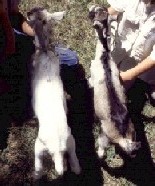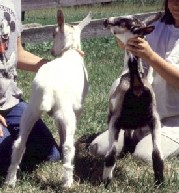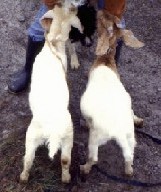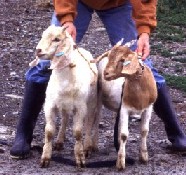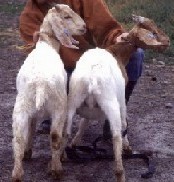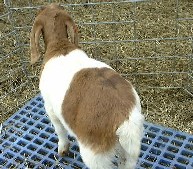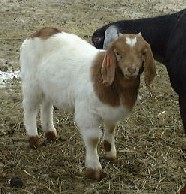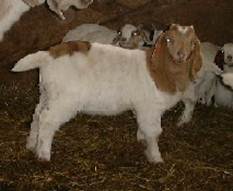Education
Evaluating Suckling Kids for Marketing
by tatiana Stanton
It is important for goat producers to be able to accurately evaluate milk fed goat kids for the Easter kid market and also as potential 4-H market goats. Selling unacceptable animals to meat buyers or 4-H youth is not only damaging to your customer but also to your reputation.
What is an Easter Kid?
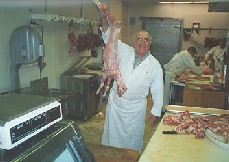 |
The term Easter kid is synonymous with hot house kid and refers to a milk fed kid no older than 10 to 12 weeks of age with light colored, succulent meat. Kids older than this or kids that have been weaned prematurely will obtain substantial portions of their diet from non-milk sources resulting in darker colored meat and lower dressing percentages, both of which are undesirable for the suckling kid market. Different ethnic groups have a preference for different weight kids. In the US, people of Italian descent often seek a suckling kid weighing 20 to 30 lb. live while families of Greek descent may prefer a suckling kid weighing 25 to 40 lbs. live. Other ethnic groups may prefer suckling kids up to about 55 lb. live weight. |
Not all suckling kids in the proper age and weight range make prime Easter kids. Buyers generally pay top dollars for suckling kids at Easter and Christmas depending on the supply. They readily assume that this price will correspond with top quality kids. It is important for producers to be able to evaluate their kids critically when targeting the Easter market.
What is a good potential 4-H market kid?
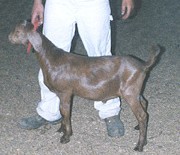 |
Children who buy goat kids as potential 4-H market kid projects may not know much about goats. They may be counting on you as a producer to help them pick out a kid from your herd that will be a prime meat animal in 3 to 4 months time. Unless the child has a great deal of experience with goats and has a cheap source of milk, you should only sell them a kid that is ready to wean. This means the kid should be a minimum of 10 to 12 weeks of age and weigh a minimum of 30 lbs. Ideally, the kid should have been gaining about ½ lb. per day in which case it will weigh about 40 to 55 lbs. The kid should be healthy, have no significant conformation faults and exhibit a good meat carcass. It should be vaccinated for tetanus and overeating disease (2 boosters of Clostridium C, D and T). |
What are unacceptable kids for these markets?
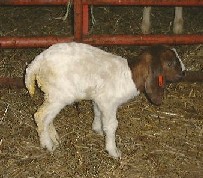 |
Unacceptable goat kids for both these markets include unhealthy kids with heavy parasite loads, unthrifty coats, hunched backs, prominent ribs, drooping tails or diarrhea. Here is one example of an unacceptable kid. |
How do you tell a really good kid from a mediocre one?
Mediocre versus prime kids can sometimes be difficult for an inexperienced producer to tell apart. The following photographs exhibit two kinds of kids that producers commonly have trouble evaluating. They are the dairy replacement kid and the so-called orphan or bottle kid.
Why do kids raised as dairy replacements not always make good meat kids?
The goal in raising an Easter kid or a 4-H market kid is not always compatible with raising a kid to become a future dairy goat. The goal in raising a doe kid at a goat dairy is to build lots of bone and develop a good size rumen at an early age on an economical diet that allows much of the dairy's milk to be diverted to processing or direct sales. The next set of photos show a pair of dairy doe kids of similar ages.
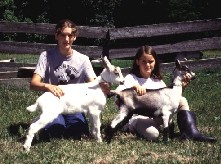 |
The white kid is a cull that has been left on her dam while the Cou Blanc (white front, dark back) kid is being reared artificially as a dairy replacement. Both kids are very healthy. However, the little Cou Blanc, like most dairy replacements, is being raised on limited amounts of milk supplemented with a high protein pelleted feed and a highly palatable hay. Although she is beautiful and healthy, she has very little meat on her and is not a prime Easter or 4-H market kid. Part of this is because of the conformation she was born with and part of this is because of the way she is being raised. |
|
As you can see, she is shorter in both height and length than the white kid. This means she will have less forearm, thigh or loin area to build muscle and hence, meat on. See how her belly has a wedge shape to it when viewed from the top. This means that her rumen is developing which makes sense given that she is already relying on solid food as her main source of feed. However, a kid with a well-developed rumen generally has a lower dressing percentage than a milk fed kid that is getting lots of milk and not consuming very much roughage (hay, grass, etc) yet. A lower dressing percentage is not desirable in suckling kids. |
|
If you were to run your hands along her topline, barrel, hips and thighs, you would find that her bone is closer to the surface when compared to the white kid. She would provide little actual meat for a consumer and her absence of fat would lead to rapid carcass dehydration and shrinkage. Although it is often difficult for dairy producers to comprehend, this beautiful animal is not a prime Easter kid. The feeding practices commonly used to produce a dairy replacement kid are rarely suitable for Easter kids. |
What can happen if your kids are not getting very much milk from their dams?
A commercial meat goat producer does not have to worry about kids that are purposely raised on restricted milk diets. Rather, it is the inadvertent drinking of too little milk because a kid is an orphan or from a large litter or from a dam with insufficient milk that causes problems for the meat goat producer. The following series of photos contrasts a pair of Boer cross kids that are obtaining different amounts of milk.
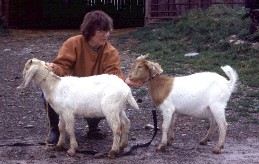 |
The kid shown on the right is an orphan being fed off a bottle or from does with surplus milk on a catch as catch can basis. She has a hay belly appearance demonstrated in the following photo due to her early reliance on hay as a major part of her diet. Just like the dairy replacement kid in the previous photos, her rumen is developing early because of her reliance on solid foods. |
|
See how her belly looks narrow at the front when viewed at her withers and front legs but wedges out sharply as you follow it back to her back legs. A large part of her weight would be a stomach full of hay. This is why her dressing percentage would be lower than a kid drinking lots of milk. Although she will probably mature into an excellent brood doe, she is not a prime Easter kid. In contrast, her male counterpart is a twin on a doe with plenty of milk. |
|
He exhibits a broad chest floor and well muscled forearms |
|
He has more muscling on his thighs and is an excellent example of an Easter kid or future 4-H market kid |
In summary,
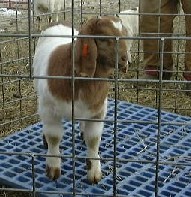 |
Look for a well muscled growthy kid with a wide chest floor and gaining about 1/2 lb. or more per day. |
|
The kid should be broad over his withers and have a wide, long back. |
|
He should be plump over his forearms and ribs, |
|
and exhibit muscling over his loin, stifle, and thigh areas. |
Happy Easter and may all your Easter kids be terrific!

